Oxidative injury and neuropathy in diabetes and impaired glucose tolerance
- PMID: 18424057
- PMCID: PMC2453225
- DOI: 10.1016/j.nbd.2008.02.013
Oxidative injury and neuropathy in diabetes and impaired glucose tolerance
Abstract
Clinical studies suggest that impaired glucose tolerance (IGT) is associated with the development of neuropathy. The aim of the current study was to determine if neuropathy developed in the female Zucker Diabetic Fatty (ZDF) rat, an animal model of IGT and type 2 diabetes. The ZDF rat develops impaired glucose tolerance (IGT) when fed a control diet, and frank diabetes when fed a high fat diet. Following 10 weeks of hyperglycemia, sensory nerve action potentials (SNAP) and compound motor action potentials (CMAP) were reduced and sensory conduction velocities were slowed (distal>proximal) in the tail and hind limb in ZDF animals with IGT and frank diabetes (p<0.01). Neuropathy was coupled with evidence of increased reactive oxygen species (ROS) and cellular injury in dorsal root ganglion (DRG) neurons from IGT animals. Our study supports the hypothesis that neuropathy develops in an animal model of IGT and is associated with evidence of oxidative injury in DRG and peripheral nerves.
Figures

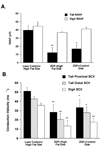
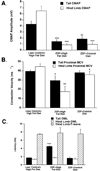
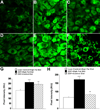
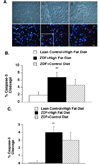
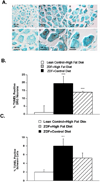
References
-
- Alberti KG, Zimmet PZ. Definition, diagnosis and classification of diabetes mellitus and its complications. Part 1: diagnosis and classification of diabetes mellitus provisional report of a WHO consultation. Diabet Med. 1998;15:539–553. - PubMed
-
- Berent-Spillson A, Robinson AM, Golovoy D, Slusher B, Rojas C, Russell JW. Protection against glucose-induced neuronal death by NAAG and GCP II inhibition is regulated by mGluR3. J Neurochem. 2004;89:90–99. - PubMed
-
- Berent-Spillson A, Russell JW. Metabotropic glutamate receptor 3 protects neurons from glucose-induced oxidative injury by increasing intracellular glutathione concentration. J Neurochem. 2007;101:342–354. - PubMed
-
- Bray GA. Experimental models for the study of obesity: introductory remarks. Fed Proc. 1977;36:137–138. - PubMed
-
- Brownlee M. Biochemistry and molecular cell biology of diabetic complications. Nature. 2001;414:813–820. - PubMed
Publication types
MeSH terms
Substances
Grants and funding
LinkOut - more resources
Full Text Sources
Medical

